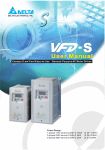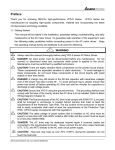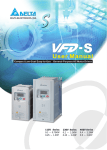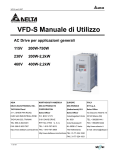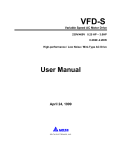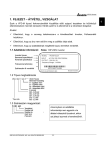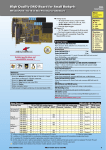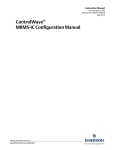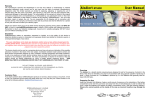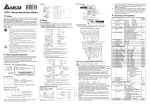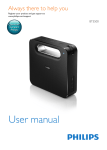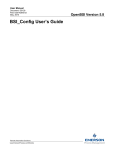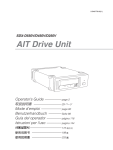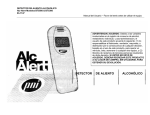Download Quick Start Manual
Transcript
Preface Thank you for choosing DELTA’s high-performance VFD-S Series. The VFD-S Series is manufactured with high-quality components and materials and incorporates the latest microprocessor technology available. Getting Started This quick start will be helpful in the installation and parameter setting of the AC motor drives. To guarantee safe operation of the equipment, read the following safety guidelines before connecting power to the AC motor drives. For detail information, refer to the VFD-S User Manual on the CD supplied with the drive. DANGER! 1. 2. 3. 4. 5. 6. 7. AC input power must be disconnected before any wiring to the AC motor drive is made. A charge may still remain in the DC-link capacitors with hazardous voltages, even if the power has been turned off. To prevent personal injury, please ensure that power has turned off before opening the AC motor drive and wait ten minutes for the capacitors to discharge to safe voltage levels. Never reassemble internal components or wiring. The AC motor drive may be destroyed beyond repair if incorrect cables are connected to the input/output terminals. Never connect the AC motor drive output terminals U/T1, V/T2, and W/T3 directly to the AC mains circuit power supply. Ground the VFD-S using the ground terminal. The grounding method must comply with the laws of the country where the AC motor drive is to be installed. Refer to the Basic Wiring Diagram. VFD-S series is used only to control variable speed of 3-phase induction motors, NOT for 1phase motors or other purpose. VFD-S series shall NOT be used for life support equipment or any life safety situation. WARNING! 1. 2. 3. DO NOT use Hi-pot test for internal components. The semi-conductor used in AC motor drive easily damage by high-pressure. There are highly sensitive MOS components on the printed circuit boards. These components are especially sensitive to static electricity. To prevent damage to these components, do not touch these components or the circuit boards with metal objects or your bare hands. Only quality person is allowed to install, wire and maintain AC motor drive. CAUTION! 1. 2. 3. 4. 5. 6. Some parameters settings can cause the motor to run immediately after applying power. DO NOT install the AC motor drive in a place subjected to high temperature, direct sunlight, high humidity, excessive vibration, corrosive gases or liquids, or airborne dust or metallic particles. Only use AC motor drives within specification. Failure to comply may result in fire, explosion or electric shock. To prevent personal injury, please keep children and unqualified people away from the equipment. When the motor cable between AC motor drive and motor is too long, the layer insulation of the motor may be damaged. Please use a frequency inverter duty motor or add an AC output reactor to prevent damage to the motor. Refer to appendix B Reactor for details. The rated voltage for AC motor drive must be ≤240V (≤480V for 460V models) and the mains supply current capacity must be ≤5000A RMS (≤10000A RMS for the ≥40hp (30kW) models). English- 1 Specifications Output Rating Voltage Class Model Number VFD-XXXS Max. Applicable Motor Output (kW) Max. Applicable Motor Output (HP) Rated Output Capacity (KVA) Rated Output Current (A) Maximum Output Voltage (V) Rated Frequency (Hz) Control Characteristics Input Rating Rated Input Current (A) Input Current for 1-phase model drive to be used as 3-phase model drive Rated Voltage/Frequency Voltage/Freq. Tolerance Control System Output Frequency Resolution Torque Characteristics Overload Endurance Accel/Decel Time V/F Pattern Stall Prevention Level Operating Characteristics Keypad Frequency Setting Operation Setting Signal External Signal Keypad -- -- 1.6 3.0 5.1 8.4 -- 022 2.2 3.0 4.4 5.5 6.9 -- -- 100/110/120 VAC 200/208/220/240 VAC 380/400/415/480 VAC 50/60 Hz 50/60Hz 50/60Hz Voltage: ±10%, Frequency: ±5% SPWM (Sinusoidal Pulse Width Modulation, carrier frequency 3k-10kHz) 0.1Hz Including the auto-torque, auto-slip compensation; starting torque can be 150% at 5Hz 150% of rated current for 1 minute 0.1to 600 second (2 Independent settings for Accel/Decel Time) V/F pattern adjustable 20 to 250%, Setting of Rated Current Setting by or Potentiometer Potentiometer-5KΩ/0.5W, DC 0 to +10V or 0 to +5V (Input impedance 47KΩ), RS-485 interface, 4 to 20mA (Input impedance 250Ω); MultiFunction Inputs 1 to 5 (7 steps, Jog, up/down) Setting by RUN, STOP External Signal M0 to M5 can be combined to offer various modes of operation, RS-485 serial interface (MODBUS). Multi-step selection 0 to7, Jog, accel/decel inhibit, first/second accel/decel Multi-Function Input Signal switch, counter, 8-step PLC operation, external Base Block (NC, NO), increase/decrease Master Frequency AC Drive Operating, Frequency Attained, Non-zero, Base Block, Fault Multi-Function Output Indication Indication, Local/Remote indication, PLC Operation indication. Analog Output Signal Analog frequency/current signal output. Installation Location Pollution Degree AVR, S-Curve, Over-Voltage/Over-Current Stall Prevention, Fault Records, Adjustable Carrier Frequency, DC Braking, Start Frequency for DC Braking, Momentary Power Loss restart, Frequency Limits, Parameter Lock/Reset, PID Feedback Control, Reverse Inhibition, etc. VFD002S21E, VFD004S21E, VFD004S43E, VFD007S21E, VFD007S43E, VFD015S21E, VFD015S43E, VFD022S21E, VFD022S43E Self-testing, Over Voltage, Over Current, Under Voltage, Overload, Overheating, External Fault, Electronic thermal, Ground Fault. Forced air-cooling (ONLY FOR 022S2XA/B; XXXS43A/B/E 1HP~3HP; XXXSXXD; XXXS21E 400W~3HP). Others are Natural air-cooling. Altitude 1,000 m or below, keep from corrosive gasses, liquid and dust 2 Ambient Temperature Storage Temperature Ambient Humidity Vibration -10°C to 40°C (Non-Condensing and not frozen) -20°C to 60°C Below 90% RH (non-condensing) 9.80665m/s2 (1G) less than 20Hz, 5.88m/s2 (0.6G) at 20 to 50Hz Other Function Built-in EMI Filter Protection Cooling Enviroment 115V Class 230V Class 460V Class 002 004 007 002 004 007 015 022 004 007 015 0.2 0.4 0.75 0.2 0.4 0.75 1.5 2.2 0.4 0.75 1.5 0.25 0.5 1.0 0.25 0.5 1.0 2.0 3.0 0.5 1.0 2.0 0.6 1.0 1.6 0.6 1.0 1.6 2.9 4.2 1.2 2.0 3.3 1.6 2.5 4.2 1.6 2.5 4.2 7.5 11.0 1.5 2.5 4.2 3-phase Proportional to 3-phase Proportional to Input Voltage Twice the Input Voltage 1.0 to 400 Hz Single phase Single/3-phase model drive 3-phase 4.9/ 6.5/ 9.7/ 15.7/ 24/ 6 9 18 1.7 2.9 5.1 1.9 2.7 5.1 9.0 15 English- 2 Basic Wiring Diagram Users must connect wiring according to the following circuit diagram shown below. For VFDXXXSXXA/B/D/U Main Circuit Power NFB R/L1 S/L2 T/L3 Recommended Circuit when power supply is turned OFF by a fault output E R/L1 S/L2 T/L3 SA MC OFF ON MC RB RC Grounding resistance less than 100 17V 4.7k 17V 4.7k 17V 4.7k 17V 4.7k 4.7k 17V 17V 17V 4.7k 47K English- 3 For VFDXXXSXXE NPN (sink mode) Braking resistor (optional) select 80Ω 120W, 200Ω 120W 400Ω 120W Jumper Main Circuit Power NFB R/L1 S/L2 T/L3 Recommended Circuit when power supply is turned OFF by a fault output +1 E R/L1 S/L2 T/L3 SA MC OFF ON MC Factory default Forward/Stop Reverse/Stop Reset Multi-step 1 Multi-step 2 Multi-step 3 Comm. signal (sink) Analog voltage 3 0~10VDC Potentiometer Pot. 2 3K~5KΩ Analog current 1 RB RC +2/B1 +17V CPU 2.4Ω 17V 11V M0 M2 NPN M3 PNP J2 GND E +10V 10mA (MAX) 2 1 AVI 3 47KΩ 250Ω GND AC Motor IM 3~ Grounding resistance less than 100Ω E 47ΩAFM 47KΩ RA RB RC M5 Factory default: output freq. (Pot.) determined by the Potentiometer on the control panel. Main circuit (power) terminals V/T2 W/T3 GND M1 M4 B2 U/T1 Potentiometer(1KΩ) + - Analog output DC 0~10V Factory default: indicate output frequency Multi-function indication output contacts below 120VAC/24VDC 5A Factory default: indicates malfunction Mo1 Multi-function Photocoupler output below 48VDC 50mA Factory default: Indicates MCM during operation RJ-11 6←1 Control circuit terminals RJ-11 communication port with RS-485 serial interface 1:17V 2:GND 3:SG4:SG+ Shielded leads NOTE: Do not plug in a Modem or telephone line to the RS-485 communication port, permanent damage may result. Terminal 1 & 2 are the power sources for the optional copy keypad and should not be used while using RS-485 communication. * If it is single phase model, please select any of the two input power terminals in main circuit power. English- 4 For VFDXXXSXXE PNP (source mode) Braking resistor (optional) select 80Ω 120W, 200Ω 120W 400Ω 120W Jumper Main Circuit Power NFB R/L1 S/L2 T/L3 Recommended Circuit when power supply is turned OFF by a fault output +1 E R/L1 S/L2 T/L3 SA MC OFF ON MC RB RC +2/B1 B2 U/T1 +17V CPU 2.4Ω V/T2 W/T3 Reverse/Stop Reset Multi-step 1 Multi-step 2 Multi-step 3 Analog voltage 3 0~10VDC Potentiometer Pot. 2 3K~5KΩ Analog current 1 17V 11V M0 47ΩAFM M2 NPN M3 PNP M4 J2 RA RB RC M5 GND E +10V 10mA (MAX) 2 1 AVI 3 47KΩ 250Ω GND Factory default: output freq. (Pot.) determined by the Potentiometer on the control panel. Main circuit (power) terminals 47KΩ GND M1 IM 3~ Grounding resistance less than 100Ω E Common signal (source) Forward/Stop AC Motor Potentiometer(1KΩ) + - Analog output DC 0~10V Factory default: indicate output frequency Multi-function indication output contacts below 120VAC/24VDC 5A Factory default: indicates malfunction Mo1 Multi-function Photocoupler output below 48VDC 50mA Factory default: Indicates MCM during operation RJ-11 6←1 Control circuit terminals RJ-11 communication port with RS-485 serial interface 1:17V 2:GND 3:SG4:SG+ Shielded leads NOTE: Do not plug in a Modem or telephone line to the RS-485 communication port, permanent damage may result. Terminal 1 & 2 are the power sources for the optional copy keypad and should not be used while using RS-485 communication. * If it is single phase model, please select any of the two input power terminals in main circuit power. English- 5 Power Terminals AC Input Line Ter minal AC Input Line Ter minal Motor Conne ction Groun d Brak ing Resi stor Groun d Figure 1: VFD002S11A/11B, VFD004S11A/11B AC Input Line Ter minal Motor Conne ction AC Input Line Ter minal G roun d Br ak ing DC Reactor Res istor Groun d Motor Conne ction Groun d Br ak ing DC Reac to r Res istor Figure 4: VFD002S21B/23A, VFD004S21B/23A/43A/43B/43E, VFD007S21B/23A/43A/43B/43E, VFD015S23D AC Input Line Terminal Motor Conne ction Br ak ing DC Reacto r Res istor Groun d Figure 5: VFD015S21U/43D/43E/43U, VFD022S21U/23D/43D/43E/43U Figure 1/figure3/figure 4: Wire Gauge: 14-20 AWG (2.1-0.5mm2) Wire Type: copper wire only, 75°C Torque: 12 kgf-cm (10 in-lbf) Br ak ing Resi stor Figure 2: VFD007S11A/B Figure 3: VFD002S21A/E, VFD004S21A/E, VFD007S21A/E AC Input Line Ter minal Motor Conne ction Motor Conne ction Brak ing DC Reacto r Res istor Figure 6: VFD015S21D/E, VFD022S21D/E Figure 2/figure5/figure 6: Wire Gauge: 10-18 AWG (5.3-0.8mm2) Wire Type: stranded copper wire only, 75°C Torque: 20 kgf-cm (17.4 in-lbf) English- 6 Terminal Explanations Terminal Symbol Explanation of Terminal Function R/L1, S/L2, T/L3 AC line input terminals (three phase) L/L1, N/L2 AC line input terminals (single phase) U/T1, V/T2, W/T3 Motor connections +2/B2 – B1 Connections for Braking Resistor (optional) +2/+1 – B1 Connections for DC Link Reactor (optional) Earth Ground Control Terminal Wiring (Factory Setting) A. XXXSXXA/B/D/U +10V RA RB RC MO1 MCM AVI AFM M0 M1 M2 M3 M4 M5 GND Operation freq. setting potentiometer VR : 3K~5K Corrector potentiometer VR : 1K~5K Freq. meter 0~10 VDC Full scale voltmeter B. XXXSXXE RJ11 Multi-step speed 3 Multi-step speed 2 Multi-step speed 1 Reset Reverse/Stop Forward/Stop * 6~1 Relay contactor output Factory setting : Fault indication Photo coupler output Factory setting : in work RS485 Communication port Wire Gauge: 24-12 AWG Wire Type: Copper Only Torque: 4 kgf-cm (3.5 in-lbf) * Multi-step speed 3 Wire Gauge: 24-16 AWG Wire Type: Copper Only Torque: 2 kgf-cm (1.7 in-lbf) English- 7 Terminal Explanations Terminal Terminal name symbols Multi-Function Indication Output RA-RC Contact Multi-Function Indication Output RB-RC Contact MO1-MCM Multi-function PHC output RJ-11 Serial communication port +10V-GND Power for speed setting Analog voltage/current freq. AVI-GND command AFM-GND Analog frequency/current meter 17V DC Voltage Source M0 Multi-function auxiliary input M1 Multi-function input 1 M2 Multi-function input 2 M3 Multi-function input 3 M4 Multi-function input 4 Multi-function input 5 M5 GND Digital Signal Common Remarks Refer to Pr.3-06 Relay output contact RA-RC (N.O. Contact) RB-RC (N.C. Contact) Refer to Pr.3-05 RS-485 serial communication interface Power Supply (+10 V/10mA) 0 to +10 V (Max. Output Frequency) Input or 4 to 20mA (Max. Output Frequency) Input 0 to +10 V (Max. output Frequency) Output (17V/20mA), used for source mode. Refer to Pr.4-04 to Pr.4-08 Note: Use twisted-shielded, twisted-pair or shielded-lead wires for the control signal wiring. It is recommended to run all signal wiring in a separate steel conduit. The shield wire should only be connected at the drive. Do not connect shield wire on both ends. Description of Digital Keypad This digital keypad includes two parts: Display panel and keypad. Display panel provides the parameter display and shows operation status of the AC drive. Keypad provides programming interface between users and AC drives. LED Display Indicate frequency, motor parameter setting value and alarm contents. LED indication Light during RUN, STOP, FWD and REV operation. RUN FWD REV Potentiometer for frequency setting. Could be the Master Frequency input by setting Pr.2-00. Mode Key Change between different display modes. MIN. MAX. STOP RUN Key Start inverter drive operation. STOP/RESET Key Stop inverter drive operation and reset the inverter after faults occurred. RUN STOP/RESET PROG DATA MODE English- 8 PROG/DATA Key Set the different parameters and enter information. UP and DOWN Key Sets the parameter number or changes the numerical data such as the freq. reference. Operation steps of the Digital Keypad MODE Change display mode Set frequency Set frequency Set frequency Change display item MODE Change operation direction MODE MODE MODE Set Freq. Change display Change display Change display mode mode mode REV state can't attain if reverse is inhibited. MODE Display freq. Command Communication error, only appears when communication error happens. Display parameter number Display parameter number PROG DATA PROG DATA Set parameter group Set parameter number PROG DATA MODE Store data Display the data of parameter Set parameter data Parameter is locked or data is out of range, or data can't be entered during RUN mode. Data is stored English- 9 Summary of Parameter Settings a: The parameter can be set during operation. Group 0 User Parameters Pr. 0-00 0-01 0-02 Explanation Settings Identity Code of the AC Motor Drive Rated Current Display of the AC Motor Drive Parameter Reset a0-03 Start-up Display Selection a0-04 Content of Multi-Function Display a0-05 0-06 0-07 0-08 a0-09 User-Defined Coefficient K Software Version Password Input Password Set Memory Mode Selections Read-only Read-only d09: All parameters are reset to factory settings d0: Display the frequency command value (LED F) d1: Display the actual output frequency (LED H) d2: Multifunction display, see Pr.0004 d3: Display output current (LED A) d4: Display forward/reverse command (Frd/rEv) d0: Display User-Defined Unit (u) d1: Display Counter Value (C) d2: Display Process Operation (1.tt) d3: Display DC-BUS Voltage ( u ) d4: Display output voltage (E) d5: Display frequency commands of PID (P) d6: Display analog feedback signal value (b) (%) d0.1 to d160 Read-only d0 to d999 d0 to d999 d0 to d63 Factory NOTE Setting d# d##.# d0 d0 d0 d1.0 d#.# d0 d0 d8 Group 1 Basic Parameters Pr. 1-00 1-01 1-02 1-03 1-04 1-05 1-06 1-07 1-08 a1-09 a1-10 a1-11 a1-12 Explanation Settings Maximum Output Frequency (Fmax) d50.0 to d400 Hz Maximum Voltage Frequency (Fbase) d10.0 to d400 Hz 230V series: d2.0V to d255V Maximum Output Voltage (Vmax) 460V series: d4.0V to d510V Mid-Point Frequency (Fmid) d1.0 to d400 Hz Mid-Point Voltage (Vmid) 230V series: d2.0V to d255V 460V series: d4.0V to d510V Minimum Output Frequency (Fmin) d1.0 to d60.0 Hz Minimum Output Voltage (Vmin) 230V series: d2.0V to d255V 460V series: d4.0V to d510V Output Frequency Upper Limit d1 to d110% Output Frequency Lower Limit d0 to d100% Accel Time 1 d0.1 to d600 Sec Decel Time 1 d0.1 to d600 Sec Accel Time 2 d0.1 to d600 Sec Decel Time 2 d0.1 to d600 Sec English- 10 Factory NOTE Setting d60.0 d60.0 d220 d440 d1.0 d12 d24 d1.0 d12.0 d24.0 d100 d0 d10.0 d10.0 d10.0 d10.0 Pr. Explanation Settings a1-13 Jog Acceleration / Deceleration Time a1-14 Jog Frequency 1-15 1-16 1-17 1-18 d0.1 to d600 Sec d1.0 Hz to d400 Hz d0: Linear Accel/Decel d1: Auto Accel, Linear Decel d2: Linear Accel, Auto Decel Auto acceleration / deceleration (refer d3: Auto Accel/Decel (Set by load) d4: Linear Accel; Auto Decel, Stall to Accel/Decel time setting) Prevention during Decel d5: Auto Accel/Decel, Stall Prevention during Decel Acceleration S-Curve d0 to d7 Deceleration S-Curve d0 to d7 d0.0 Jog Decelerating Time Jog Decelerating Time Determined by Pr.1-13 d0.1 to d600 Factory NOTE Setting d10.0 d6.0 d0 d0 d0 d0.0 Group 2 Operation Method Parameters Pr. 2-00 Explanation Source of Master Frequency Command Settings d0: Master Frequency input determined by digital keypad. (record the frequency of power loss and it can do analog overlap plus) d1: Master Frequency determined by analog signal DC 0V-10V (external terminal AVI). (won’t record the frequency of power loss and it can’t do analog overlap plus) d2: Master Frequency determined by analog signal DC 4mA 20mA (external terminal AVI). (won’t record the frequency of power loss and it can’t do analog overlap plus) d3: Master Frequency determined by Potentiometer on the digital keypad. (won’t record the frequency of power loss and it can do analog overlap plus) d4: Master Frequency operated by RS-485 serial communication interface and record frequency of power loss. (record the frequency of power loss and it can do analog overlap plus) English- 11 Factory NOTE Setting d0 Pr. Explanation Settings 2-00 Source of Master Frequency Command 2-01 Source of Operation Command 2-02 Stop Method 2-03 PWM Carrier Frequency Selections 2-04 2-05 2-06 d5: Master Frequency operated by RS-485 serial communication interface and won’t record frequency before power loss. (won’t record the frequency of power loss and it can do analog overlap plus) d0: Digital Keypad d1: External terminals. Keypad STOP/RESET enabled. d2: External terminals. Keypad STOP/RESET disabled. d3: RS-485 serial communication (RJ-11) .Keypad STOP/RESET enabled. d4: RS-485 serial communication (RJ-11). Keypad STOP/RESET disabled. d0: STOP: ramp to stop; E.F.: coast to stop d1: STOP: coast to stop; E.F.: coast to stop d3: 3KHz d7: 7KHz d4: 4KHz d8: 8KHz d5: 5KHz d9: 9KHz d6: 6KHz d10: 10KHz d0: Enable forward/reverse operation d1: Disable reverse operation d0: Decelerate to 0 Hz d1: Coast to stop and display “EF” Loss of ACI Signal d2: Continue operation by last frequency command d0: Disable Analog Auxiliary Frequency Operation d1: Enable + AVI d2: Enable + ACI Motor Direction Control Factory NOTE Setting d0 d0 d0 d10 d0 d0 d0 Group 3 Output Function Parameters Pr. 3-00 Explanation Settings d0: analog frequency meter d1: analog current meter Analog Output Signal a3-01 Analog Output Gain 3-02 Desired Frequency Attained 3-03 3-04 3-05 d1 to d200% d1.0 to d400 Hz Terminal Count Value Preliminary Count Value Multi-Function Output Terminal 1 (Photocoupler Output) Factory NOTE Setting d0 d100 d1.0 d0 to d999 d0 to d999 d0 d0 d0: No Function d1 English- 12 Pr. 3-06 Explanation Settings Multi-Function Output Terminal 2 (Relay Output) d1: AC Drive Operational d2: Master Frequency Attained d3: Zero Speed d4: Over Torque Detection d5: Base-Block (B.B.) Indication d6: Low-Voltage Indication d7: Operation Mode Indication d8: Fault Indication d9: Desired Frequency Attained d10: PLC Program Running d11: PLC Program Step Completed d12: PLC Program Completed d13: PLC Program Operation Paused d14: Terminal Count Value Attained d15: Preliminary Count Value Attained d16: AC Motor Drive Ready d17: FWD command Indication d18: REV command Indication Factory NOTE Setting d8 Group 4 Input Function Parameters Pr. Explanation Settings a4-00 Potentiometer Bias Frequency Potentiometer Bias a4-01 Polarity Potentiometer a4-02 Frequency Gain Potentiometer Reverse 4-03 Motion Enable 4-04 d 0.0 to d 100.0% d0: Positive Bias d1: Negative Bias d1 to d200 % d0: Forward Motion Only d1: Reverse Motion enabled Multi-Function Input Terminal 1 (M0, M1) Multi-Function Input Terminal 2 (M2) 4-05 Multi-Function Input Terminal 3 (M3) 4-06 Multi-Function Input Terminal 4 (M4) 4-07 d0: No Function d1: FWD/STOP, REV/STOP d2: FWD/REV, RUN/STOP d3: 3-wire Operation Control Mode d4: E.F. External Fault Input (N.O.) d5: E.F. External Fault Input (N.C.) d6: Reset d7: Multi-Step Speed Command 1 d8: Multi-Step Speed Command 2 d9: Multi-Step Speed Command 3 d10: Jog Operation d11: Accel/decel Inhibit d12: First or Second Acceleration/deceleration Time Selection d13: External base block (N.O.) d14: External base block (N.C.) d15: Up: Increment master frequency d16: Down: Decrement master frequency d17: Run PLC Program English- 13 Factory NOTE Setting d0.0 d0 d100 d0 d1 d6 d7 d8 Pr. Explanation Settings 4-08 Multi-Function Input Terminal 5(M5) 4-09 Line Start Lockout 4-10 Up/Down Mode 4-11 Accel/Decel Rate of Change of UP/DOWN Operation with Constant Speed d18: Pause PLC Program d19: Counter Trigger Signal d20: Counter Reset d21: Select ACI / Deselect AVI d22: PID Function Disabled d23: JOG FWD d24: JOG REV d25: The source of master frequency is AVI. d26: The source of master frequency is ACI. d27: Press UP/DOWN key to switch forward/reverse (N.O.) motion d28: Press UP/DOWN key to switch forward/reverse (N.C.) motion d29: M0: 0: RUN 1: STOP, M1: no function, Direction is controlled by keypad d0: Disable d1: Enable d0: Based on accel/decel time d1: Up frequency according to constant speed, down frequency according to deceleration time d2: Up frequency according to acceleration time, down frequenc according to constant speed d3: Constant speed 0~1000, unit: 5 Hz/sec Factory NOTE Setting d9 d0 d3 d1 Group 5 Multi-Step Speed and PLC Parameters Pr. Explanation 5-00 5-01 5-02 5-03 5-04 5-05 5-06 1st Step Speed Freq. 2nd Step Speed Freq. 3rd Step Speed Freq. 4th Step Speed Freq. 5th Step Speed Freq. 6th Step Speed Freq. 7th Step Speed Freq. 5-07 PLC Mode Settings d0.0 to d400 Hz d0.0 to d400 Hz d0.0 to d400 Hz d0.0 to d400 Hz d0.0 to d400 Hz d0.0 to d400 Hz d0.0 to d400 Hz d0: Disable PLC Operation d1: Execute one program cycle d2: Continuously execute program cycles d3: Execute one program cycle step by step d4: Continuously execute one program cycle step by step English- 14 Factory NOTE Setting d0.0 d0.0 d0.0 d0.0 d0.0 d0.0 d0.0 d0 Pr. Explanation Settings Factory NOTE Setting d5: Disable PLC operation, but can set direction of 1st speed to 7th speed 5-08 5-09 5-10 5-11 5-12 5-13 5-14 5-15 5-16 PLC Forward/ Reverse Motion Time Duration of Zero Step Speed Time Duration of 1st Step Speed Time Duration of 2nd Step Speed Time Duration of 3rd Step Speed Time Duration of 4th Step Speed Time Duration of 5th Step Speed Time Duration of 6th Step Speed Time Duration of 7th Step Speed d0 to d255 (0: FWD 1: REV) d0 d0 to d65500 Sec d0 to d65500 Sec d0 to d65500 Sec d0 to d65500 Sec d0 to d65500 Sec d0 to d65500 Sec d0 to d65500 Sec d0 to d65500 Sec d0 d0 d0 d0 d0 d0 d0 d0 Group 6 Protection Parameters Pr. 6-00 6-01 Explanation Settings Over-Voltage Stall Prevention Over-Voltage Stall Prevention Level 6-02 Over-Current Stall Prevention Level 6-03 Over-Torque Detection Mode 6-04 6-05 Over-Torque Detection Level Over-Torque Detection Time Electronic Thermal Overload Relay 6-06 Selection Electronic Thermal a6-07 Characteristic 6-08 Present Fault Record d0: Disable d1: Enable 115V/230V series: d350 to d410V 460V series: d700 to d820V d20 to d150% d0: Disabled d1: Enabled during constant speed operation. After the over-torque is detected, keep running until OL1 or OL occurs. d2: Enabled during constant speed operation. After the over-torque is detected, stop running. d3: Enabled during running and continues before Continuous Output Time Limit (Pr.6-05) is reached d4: Enabled during running. After the over-torque is detected, stop running. d30 to d200% d0.1 to d10.0 Sec Factory NOTE Setting d1 d390 d780 d130 d0 d150 d0.1 d0 to d2 d2 d30 to d600 Sec d60 d0: No fault d1: Over current (oc) d2: Over voltage (ov) d3: Over heat (oH) d4: Over load (oL) d5: Over load (oL1) d6: External fault (EF) d7: Reserved d0 English- 15 Pr. Explanation Settings 6-09 Second Most Recent Fault Record 6-10 Third Most Recent Fault Record d8: Reserved d9: Excess current during acceleration (ocA) d10: Excess current during deceleration (ocd) d11: Excess current during steady state (ocn) d12: Ground fault (GF) d13: Reserved d14: Low voltage (Lv) d15: CPU failure 1 (cF1) d16: CPU failure 2 (cF2) d17: Base block (b.b.) d18: Overload (oL2) d19: Auto acceleration/deceleration failure (cFA) d20: Software protection enable (codE) d21: Reserved d22: CPU failure (cF3.1) d23: CPU failure (cF3.2) d24: CPU failure (cF3.3) d25: CPU failure (cF3.4) d26: CPU failure (cF3.5) d27: CPU failure (cF3.6) d28: CPU failure (cF3.7) d29: Hardware protection failure (HPF.1) d30: Hardware protection failure (HPF.2) d31: Hardware protection failure (HPF.3) d32: Communication time-out (CE10) d33: Reserved d34: Software error (SErr) d35: Reserved d36: PID error (Pld) d37: Reserved d38: Phase loss (PHL) Factory NOTE Setting d0 Group 7 Motor Parameters Pr. a7-00 a7-01 a7-02 a7-03 Explanation Motor Rated Current Motor No-Load Current Torque Compensation Slip Compensation Settings d30 to d120% d0 to d90% d0 to d10 d0.0 to d10.0 Factory NOTE Setting d85 d50 d1 d0.0 Group 8 Special Parameters Pr. 8-00 Explanation DC Braking Voltage Level Settings d0 to d30% English- 16 Factory NOTE Setting d0 Pr. Explanation Settings 8-01 8-02 8-03 DC Braking Time during Start-Up DC Braking time during Stopping Start-Point for DC Braking 8-04 Momentary Power Loss Operation Selection 8-06 8-07 8-08 8-09 8-10 8-11 8-12 8-13 8-14 Maximum Allowable Power Loss Time B.B. Time for Speed Search Current Limit for Speed Search Skip Frequency 1 Upper Limit Skip Frequency 1 Lower Limit Skip Frequency 2 Upper Limit Skip Frequency 2 Lower Limit Skip Frequency 3 Upper Limit Skip Frequency 3 Lower Limit Auto Restart After Fault 8-15 AVR Function 8-05 8-16 8-17 Software Braking Level DC Braking Lower Bound Limit d0.0 to d60.0 Sec d0.0 to d60.0 Sec d0.0 to d400 Hz d0: Operation stops after Momentary Power Loss d1: Operation continues after momentary power loss, speed search starts with the Master Frequency reference value d2: Operation continues after momentary power loss, speed search starts with the minimum frequency Factory NOTE Setting d0.0 d0.0 d0.0 d0 d0.3 to d5.0 Sec d2.0 d0.3 to d5.0 Sec d30 to d200% d0.0 to d400 Hz d0.0 to d400 Hz d0.0 to d400 Hz d0.0 to d400 Hz d0.0 to d400 Hz d0.0 to d400 Hz d0 to d10 d0: Enable d1: Disable d2: Disable when deceleration 115V/230V series: d350 to d450V 460V series: d700 to d900V d0.0 to d400 Hz d0.5 d150 d0.0 d0.0 d0.0 d0.0 d0.0 d0.0 d0 d2 d380 d760 d0.0 Group 9 Communication Parameters Pr. a9-00 Explanation Communication Address a9-01 Transmission Speed a9-01 Transmission Speed a9-02 Transmission Fault Treatment a9-03 Time-out Detection a9-04 Communication Protocol Settings d1 to d254 d0: Baud Rate 4800 bps d1: Baud Rate 9600 bps d2: Baud Rate 19200 bps d3: Baud Rate 38400 bps d0: Warn and Keep Operating d1: Warn and Ramp to Stop d2: Warn and Coast to Stop d3: Keep Operating without Warning d0: Disable d1 to d20: time setting (1 sec increment) d0: 7,N,2 (Modbus, ASCII) d1: 7,E,1 (Modbus, ASCII) d2: 7,O,1 (Modbus, ASCII) d3: 8,N,2 (Modbus, ASCII) English- 17 Factory NOTE Setting d1 d1 d1 d0 d0 d0 Pr. Explanation Settings Factory NOTE Setting d4: 8,E,1 (Modbus, ASCII) d5: 8,O,1 (Modbus, ASCII) d6: 8,N,2 (Modbus, RTU) d7: 8,E,1 (Modbus, RTU) d8: 8,O,1 (Modbus, RTU) Group A PID Parameters Pr. Explanation Settings Factory NOTE Setting Input terminal for PID Feedback d0: Disable PID function d1: Negative PID feedback from external terminal (AVI) 0 to +10V d2: Negative PID feedback from external terminal (ACI) 4 to 20mA d3: Positive PID feedback from external terminal (AVI) 0 to +10V d4: Positive PID feedback from external terminal (ACI) 4 to 20mA A-01 Gain over PID Detection value d0 to d999 A-02 Proportional Gain (P) d0 to d999 d100 A-03 Integral Time (I) d0 to d999 d100 A-04 Derivative Control (D) d0 to d100 A-05 Upper Bound for Integral Control d0 to d100% A-06 Primary Delay Filter Time d0 to d999 A-07 A-08 PID Output Freq. Limit Feedback Signal Detection Time d0 to d110% d0.0 to d650 seconds Treatment of the Erroneous Feedback Signals Sleep Frequency Wakeup Frequency Sleep Period PID User Defined d0: warn and RAMP to stop d1: warn and COAST to stop d0.0 to d400Hz d0.0 to d400Hz d0.0 to d650 seconds d0.0 to d400 A-00 A-09 A-10 A-11 A-12 A-13 d0 d100 d0 d100 d0 d100 d0.0 d0 d0.0 d0.0 d0.0 d0.0 Fault Codes Fault Name Fault Descriptions Over current Abnormal increase in current. Corrective Actions 1. Check if motor power corresponds with the AC motor drive output power. 2. Check the wiring connections to U/T1, V/T2, W/T3 for possible short circuits. 3. Check the wiring connections between the AC motor drive and motor for possible short circuits, also to ground. English- 18 Fault Name Fault Descriptions Corrective Actions Over current Abnormal increase in current. Over voltage The DC bus voltage has exceeded its maximum allowable value. Overheating Heat sink temperature too high Low voltage The AC motor drive detects that the DC bus voltage has fallen below its minimum value. Overload The AC motor drive detects excessive drive output current. NOTE: The AC motor drive can withstand up to 150% of the rated current for a maximum of 60 seconds. Overload 1 Internal electronic overload trip Overload 2 Motor overload. Over-current during acceleration 4. Check for loose contacts between AC motor drive and motor. 5. Increase the Acceleration Time. 6. Check for possible excessive loading conditions at the motor. 7. If there are still any abnormal conditions when operating the AC motor drive after a shortcircuit is removed and the other points above are checked, it should be sent back to manufacturer. 1. Check if the input voltage falls within the rated AC motor drive input voltage range. 2. Check for possible voltage transients. 3. DC-bus over-voltage may also be caused by motor regeneration. Either increase the Decel. Time or add an optional brake resistor. 4. Check whether the required braking power is within the specified limits. 1. Ensure that the ambient temperature falls within the specified temperature range. 2. Make sure that the ventilation holes are not obstructed. 3. Remove any foreign objects from the heatsinks and check for possible dirty heat sink fins. 4. Check the fan and clean it. 5. Provide enough spacing for adequate ventilation. 1. Check whether the input voltage falls within the AC motor drive rated input voltage range. 2. Check whether the motor has sudden load. 3. Check for correct wiring of input power to R-S-T (for 3-phase models) without phase loss. 1. 2. 3. Check whether the motor is overloaded. Reduce torque compensation setting in Pr.702 Take the next higher power AC motor drive model. 1. 2. 3. 4. Check for possible motor overload. Check electronic thermal overload setting. Use a higher power motor. Reduce the current level so that the drive output current does not exceed the value set by the Motor Rated Current Pr.7-00. 1. Reduce the motor load. 2. Adjust the over-torque detection setting to an appropriate setting (Pr.6-03 to Pr.6-05). 1. Short-circuit at motor output: Check for possible poor insulation at the output lines. 2. Torque boost too high: Decrease the torque compensation setting in Pr.7-02 English- 19 Fault Name Fault Descriptions Corrective Actions Over-current during acceleration 3. Acceleration Time too short: Increase the Acceleration Time. 4. AC motor drive output power is too small: Replace the AC motor drive with the next higher power model. 1. Short-circuit at motor output: Check for possible poor insulation at the output line. Deceleration Time too short: Increase the Deceleration Time. AC motor drive output power is too small: Replace the AC motor drive with the next higher power model. Short-circuit at motor output: Check for possible poor insulation at the output line. Sudden increase in motor loading: Check for possible motor stall. AC motor drive output power is too small: Replace the AC motor drive with the next higher power model. When multi-function input terminals (MI1-MI6) are set to external fault, the AC motor drive stops output U, V and W. Give RESET command after fault has been cleared. 2. Over-current during deceleration 3. 1. 2. Over-current during steady state operation 3. 1. External Fault 2. Internal EEPROM can not be programmed. Internal EEPROM can not be programmed. Return to the factory. Return to the factory. 1. 2. Drive’s internal circuitry abnormal. Switch off power supply. Check whether the input voltage falls within the rated AC drive input voltage. Switch on the AC drive. Hardware protection failure. Return to the factory. Software protection failure Return to the factory. 1. Check if the motor is suitable for operation by AC motor drive. 2. Check if the regenerative energy is too large. 3. Load may have changed suddenly. When (one of) the output terminal(s) is grounded, short circuit current is more than 50% of AC motor drive rated current, the AC motor drive power module may be damaged. NOTE: The short circuit protection is provided for AC motor drive protection, not for protection of the user. 1. Check whether the IGBT power module is damaged. 2. Check for possible poor insulation at the output line. Auto accel/decel failure Ground fault English- 20 Fault Name Fault Descriptions Corrective Actions 1. Check the RS485 connection between the AC motor drive and RS485 master for loose wires and wiring to correct pins. Check if the communication protocol, address, transmission speed, etc. are properly set. When the external input terminal (B.B) is active, the AC motor drive output will be turned off. Deactivate the external input terminal (B.B) to operate the AC motor drive again. Communication Error 2. 1. External Base Block. (Refer to Pr. 8-06) 2. Dimensions are in mm [inch] C F E B A D Model Name 002S11A/21A/23A 004S11A/21A/23A 004S43A/43E, 007S21A/23A 007S43A/43E 002S21E, 004S21E, 007S21E, 015S23D 002S11B/21B/23B 004S11B/21B/23B 004S43B, 007S21B/23B A 85.0 [3.35] 85.0 [3.35] 85.0 [3.35] 85.0 [3.35] 85.0 [3.35] 85.0 [3.35] 85.0 [3.35] 85.0 [3.35] I H G 5.0 [0.20] B 148.0 [5.83] 148.0 [5.83] 148.0 [5.83] 148.0 [5.83] 148.0 [5.83] 148.0 [5.83] 148.0 [5.83] 148.0 [5.83] C 88.0 [3.47] 102.0 [4.02] 124.0 [4.89] 126.0 [4.96] 127.0 [5.00] 88.0 [3.47] 102.0 [4.02] 124.0 [4.89] D 74.0 [2.92] 74.0 [2.92] 74.0 [2.92] 74.0 [2.92] 74.0 [2.92] 74.0 [2.92] 74.0 [2.92] 74.0 [2.92] English- 21 E 132.2 [5.21] 132.2 [5.21] 132.2 [5.21] 132.2 [5.21] 133.7 [5.27] 132.2 [5.21] 132.2 [5.21] 132.2 [5.21] F 5.8 [0.23] 5.8 [0.23] 5.8 [0.23] 5.8 [0.23] 5.8 [0.23] 5.8 [0.23] 5.8 [0.23] 5.8 [0.23] G H I - - - - - - - - - - - - - - - 73.0 [2.88] 73.0 [2.88] 73.0 [2.88] 16.0 [0.63] 16.0 [0.63] 16.0 [0.63] 67.8 [2.67] 67.8 [2.67] 67.8 [2.67] Model Name 007S43B A 85.0 [3.35] B 148.0 [5.83] C 126.0 [4.96] D 74.0 [2.92] E 132.2 [5.21] F 5.8 [0.23] G 73.0 [2.88] H 16.0 [0.63] I 67.8 [2.67] G H I - - - - - - Dimensions are in mm [inch] B I H G 5.5 [0.22] Model Name C F E A D A B C D E F 100.0 [3.94] 100.0 [3.94] 186.0 [7.33] 186.0 [7.33] 143.0 [5.63] 129.3 [5.09] 86.5 [3.41] 86.5 [3.41] 173.0 [6.82] 173.0 [6.82] 5.4 [0.21] 5.4 [0.21] 100.0 [3.94] 186.0 [7.33] 129.0 [5.08] 86.5 [3.41] 173.0 [6.82] 5.4 [0.21] - - - 022S21A 118.0 [4.65] 220.0 [8.67] 130.9 [5.16] 105.5 [4.16] 207.0 [8.16] 4.4 [0.17] - - - 007S11B, 015S21B/23B/43B, 022S23B/43B 100.0 [3.94] 186.0 [7.33] 129.0 [5.08] 86.5 [3.41] 173.0 [6.82] 5.4 [0.21] 73.0 [2.88] 16.0 [2.67] 67.8 [2.67] 118.0 [4.65] 100.0 [3.94] 220.0 [8.67] 186.0 [7.33] 130.9 [5.16] 129.3 [5.09] 105.5 [4.16] 86.5 [3.41] 207.0 [8.16] 173.0 [6.82] 4.4 [0.17] 5.4 [0.21] 73.0 [2.88] 73.0 [2.88] 16.0 [2.67] 16.0 [2.67] 67.8 [2.67] 67.8 [2.67] 015S21A/23A 015S21D/21E, 022S21D/21E/23D 007S11A, 015S43A/43E, 022S23A/43A/43E 022S21B 015S21U/43U 022S21U/43U English- 22






















